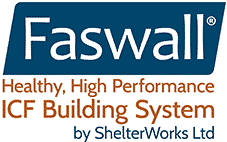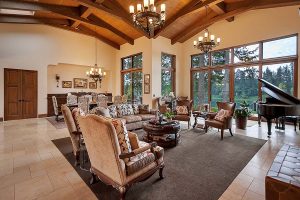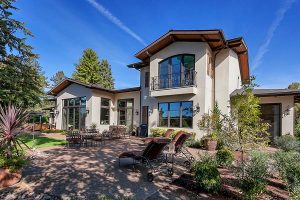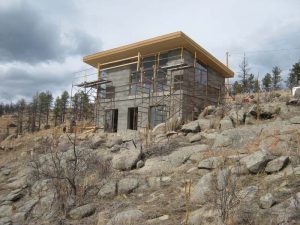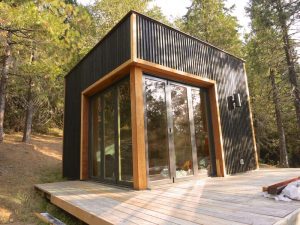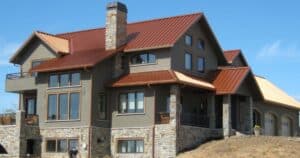Is Mold in My Home a Big Deal?
No one wants mold to grow in their home, but did you know that mold can lead to health problems for some people and magnify issues for others with existing conditions? For individuals with allergies and asthma, mold can be a serious problem. When most people think of allergens, they think of pollen and animal dander. However, many individuals are also allergic to mold. When exposed to mold, some people experience irritation in their eyes, skin, nose, throat, or lungs. Reactions to mold exposure can be as small as a stuffy nose or as extreme as shortness of breath, not to mention red or itchy eyes and skin irritation. Because of these adverse reactions to mold, it is important to be proactive in the design, construction, and maintenance of your residence to create an allergy-free home (or at least as close as humanly possible). In this article, we will discuss how to build a mold-resistant home, including allergy prevention construction techniques, recommendations for mold-resistant building materials, and practical tips for preventing mold growth once your home is complete.
If you are building a new home and your mold allergies are severe enough, you may want to consult a mold specialist before you begin construction, as it is far easier to prevent mold from growing in your home than it is to get rid of it.
Fun Fact: Molds are classified into three hazard levels
- Class A: These are the most dangerous classification of mold and can cause direct health threats because they can create toxins or cause infections.
- Class B: This type of mold can trigger allergic reactions, particularly with prolonged exposure over long periods.
- Class C: These molds are not known to have health risks
Learn More Here
Choosing Mold-Resistant Building Materials
Why Materials Matter
The first step in building a mold-resistant home is choosing the right materials for the job. The type of materials you choose to build with can greatly influence the potential amount of mold growth in your home. Some common materials can provide mold with a perfect home for growth. Mold often feeds on dead organic matter, meaning that in addition to human food, wood, paper, carpet, glue, grease, textiles, and drywall can be a breeding ground for mold. When choosing mold-resistant building materials, you want to look for materials that are breathable and moisture resistant (and ideally non-toxic).
Choosing materials that are breathable and moisture-resistant can help prevent the growth of mold in your home. Moisture is a key factor in mold growth, which is why proper ventilation is a key strategy in mold prevention. Air movement can help to minimize moisture buildup, thus preventing mold growth. Unfortunately, fungicides and other biocides used in mold prevention can be an irritant for individuals with allergies and can exacerbate existing issues. Thus, non-toxic building materials, ones that are natural and do not require the use of fungicides, are preferable when looking for hypoallergenic building materials.
Recommended Mold-Resistant Building Materials
Faswall Blocks: A Healthy, Naturally Mold-Resistant Choice
One standout material in mold-resistant construction is Faswall. Made from recycled wood and cement, Faswall blocks are breathable, hypoallergenic, and naturally mold-resistant. They contain no toxic additives or chemical treatments, making them ideal for allergy-sensitive individuals and green building practices. Faswall also helps regulate indoor humidity, a key factor in mold prevention.
Metal
Metal is a great choice for a mold-resistant building material since it does not absorb water and will not rot or support fungal growth. You can eliminate a food source for mold by choosing to switch from wood to metal framing.
Mold-Resistant Wood
If you really want to use wood to build your home, you can always consider mold-resistant wood. This is wood that has been treated with anti-mold chemicals that usually make the wood resistant to both mold and termites. If you choose to use treated wood, we highly recommend looking for a certified product to ensure that it does not release any harmful emissions. Even if the anti-mold chemicals prevent the growth of the main allergen (mold) on the wood, breathing in chemicals can be harmful to individuals with allergies or asthma.
Magnesium Oxide and Cementitious Boards
Unlike standard drywall, which is prone to mold growth when exposed to moisture, magnesium oxide and cementitious boards are highly resistant to water and mold, making them an excellent option for building a mold-resistant home.
Mold-Resistant Drywall
Another option for mold-resistant building materials is mold-resistant drywall, usually made from gypsum board and fiberglass. In addition to fiberglass’s built-in anti-mold chemicals, this type of drywall does not use paper, thus eliminating a potential source of food for mold growth. Be careful when you are looking for mold-resistant drywall. Water-resistant and mold-resistant are not synonymous. While water-resistant drywall is designed to reduce moisture, water damage, and leaks, it still has a paper facing. As mentioned above, paper can be used by mold as a food source.
Mold-Resistant Insulation
Our top recommendation for mold-resistant insulation is mineral wool insulation. This type of insulation is naturally water-repellent and mold-resistant as it is made of inorganic materials, thus depriving mold of a food source.
Another option for mold-resistant insulation is fiberglass. Fiberglass is made with chemicals that prevent the growth of mold, and some companies choose to treat their fiberglass with fungicide to provide an extra layer of protection.
Mold-Resistant Paint
Mold-resistant paints can be applied to drywall, wood, or masonry to prevent surface mold. However, it won’t kill existing mold—any current growth must be removed first. Opt for low-VOC (volatile organic compound) mold-resistant paints to reduce chemical exposure while protecting surfaces.
Mold-Resistant Caulk
Sealing cracks and gaps is vital in moisture control. Many mold-resistant caulks include fungicides to prevent staining, odor, and fungal growth. Like paint, never apply caulk over moldy surfaces—always clean and dry them first.
Mold-Resistant Sealant
Sealants can be used to form a barrier over wood, drywall, and other construction materials to reduce the possibility of mold growth by sealing the materials off from potential sources of moisture. Mold-resistant sealants often contain antimicrobial chemicals to reduce the chances of fungal growth.
Design Choices That Minimize Allergens
Effective Home Layout For Allergy Prevention
A core principle of allergy prevention construction techniques is zoning your home into wet and dry areas to help control moisture, which is a primary trigger for mold and allergens. By keeping wet activities confined to designated zones and ensuring these spaces are properly ventilated, you reduce the chances of moisture and mold spreading throughout the home.
- Wet Zones: Kitchens, bathrooms, and laundry areas are exposed to high humidity. These areas should be built using mold-resistant building materials such as Faswall blocks, moisture-proof drywall, and mold-resistant sealant.
- Dry Zones: Bedrooms, living rooms, and offices should remain low in humidity to reduce allergens. Choose hypoallergenic building materials like hardwood flooring, non-toxic paints, and low-VOC finishes.
Ventilation: A Key Ingredient to Building a Mold-Resistant Home
Humidity and stagnant air allow mold to grow and flourish. Therefore, proper ventilation is crucial for building a mold-resistant home, especially in moisture-prone areas. Here are some practical tips for healthy ventilation:
1. Install Exhaust Fans
Any room you have designated as a wet zone in your home layout, such as bathrooms, kitchens, and laundry rooms, should be equipped with exhaust fans, allowing you to vent humid air directly outside.
2. Choose a High-Quality HVAC System with HEPA Filters
It is best practice in allergy prevention construction techniques to invest in a high-quality HVAC system with HEPA filters to trap allergens like pollen, dust, and mold spores. In my experience, a HEPA filter was a huge step in reducing allergens in my home, allowing me to breathe easier even with multiple pets in the worst part of allergy season.
3. Cross-Ventilation for an Allergy-Free Home
Design the home to enable cross-ventilation by aligning windows and openings to allow air to pass through. This is a simple but effective hypoallergenic construction technique.
4. Ventilate as Much as Possible During Construction
During the building phase, keep windows and doors open when weather permits and humidity is below 60%. This ensures natural drying of materials. Avoid using heaters to speed up drying, as they can create excess humidity. Instead, use fans and dehumidifiers to maintain healthy moisture levels.
DIY-Friendly Design Tips
Bathroom and Flooring Design
Bathrooms are hotspots for moisture. Slope all bathroom surfaces, especially around showers and tubs, to promote proper drainage. This reduces standing water, one of mold’s favorite environments. You can achieve this with pre-sloped shower pans or careful tiling during the installation phase.
Avoid carpet, especially in moisture-prone areas. Carpet and carpet pads trap moisture and provide an organic material that serves as food for mold. Instead, opt for hard, mold-resistant flooring materials like tile, vinyl, or sealed concrete. These not only resist moisture but also align with hypoallergenic building materials standards.
Design for Easy Cleaning
The easier it is to clean your home, the less likely mold and allergens are to accumulate. Consider installing central vacuum systems, which reduce airborne dust and mold spores compared to traditional vacuums. Choose smooth, non-porous surfaces that are quick to wipe down, especially in kitchens, bathrooms, and laundry areas.
Tips for Everyday Allergen Prevention
Control Indoor Humidity
The ideal indoor humidity is around 30-50%. If you regularly experience humidity levels above 60%, consider using a dehumidifier to maintain safe levels.
Seal Air Leaks and Fix Water Damage Promptly
Even minor leaks can lead to major mold issues if given the time to fester. Address leaks in plumbing, roofing or windows as soon as you can.
Regular Maintenance
Your HVAC system with HEPA filters will only help with allergy prevention as long as you maintain it properly. Clean or replace your filters regularly and ensure that your fans and vents are dust-free and functioning properly.
These basic tasks are central to building and maintaining allergy-free homes.
When to Call a Pro
Some parts of building a mold-resistant home are best left to professionals, especially when dealing with systems that require technical expertise or when mold has already appeared. You should bring in a professional for these situations:
- Advanced air-sealing and envelope design: These systems ensure your home is airtight yet breathable, preventing moisture accumulation without trapping stale air.
- Whole-home dehumidification and smart ventilation systems: These setups balance humidity throughout the home and adapt to changes in air quality or moisture levels.
- Building science consultation: Experts in this field can help you implement hypoallergenic construction techniques tailored to your climate and lifestyle.
- Mold in your HVAC system: Your HVAC system should be inspected regularly for signs of mold. If contamination is discovered, turn the system off immediately and contact a licensed remediation specialist. Continuing to run a mold-contaminated HVAC system can spread spores throughout the home. Similarly, if you discover mold growth during construction, pause work in the affected area and bring in professionals for safe remediation. This prevents exposing your crew to health risks and limits further contamination.
Hypoallergenic Construction Techniques: Building With Health in Mind
Knowing how to build a mold-resistant home means thinking beyond finishes and furnishings—it begins at the construction site. Decisions made during the building process directly impact the long-term health of your home. Whether you’re a homeowner, builder, or DIY enthusiast, incorporating these hypoallergenic construction techniques will set the foundation for a cleaner, safer, and allergy-free home.
1. Moisture Management During Construction
Effective moisture control is the most important step in preventing mold. During the early stages of construction, how materials are stored and handled matters.
- Protect Building Materials: Keep lumber elevated and covered to avoid moisture absorption. If left on damp ground, wood can absorb moisture and become a breeding ground for mold even before installation.
- Moisture Testing: Before sealing walls, check the moisture content of framing lumber.
- Dehumidify Early: Once the building envelope is complete, place a dehumidifier in the basement to reduce lingering moisture, especially during humid seasons or rainy builds.
2. Insulate Cold Surfaces
Mold doesn’t need light to grow—only moisture. One of the most common sources of hidden moisture is condensation, especially on cold surfaces like pipes and HVAC ducts. To prevent this, insulate all cold water lines and metal surfaces, especially those in basements and crawl spaces. Additionally, use thermal insulation wraps to prevent condensation from forming, which often leads to mold growth behind walls or under floors.
3. Smart Use of Water-Resistant Materials
Water-resistant drywall and materials have their place, but knowing where to use them is key. These materials are best used inside wet zones like kitchens, bathrooms, laundry rooms, and mudrooms—not on exterior walls.
Why? Water-resistant drywall doesn’t breathe. If used on exterior walls, it can trap moisture inside wall cavities, leading to rotting studs and hidden mold growth. Stick to breathable assemblies (like Faswall blocks) for outer walls and reserve non-permeable products for interior moisture-prone areas.
4. Avoiding Off-Gassing and Indoor Air Pollution
Many building products release VOCs (volatile organic compounds), which can irritate respiratory systems and trigger allergies. During construction, choose low- or zero-VOC paints, sealants, and adhesives and allow adequate curing and acclimatization time for materials before sealing them into place.
5. Sealing and Drainage Details
Water entry points must be proactively sealed to prevent future mold problems. Seal all potential entry points: Behind tubs, under flooring, around windows, and in exterior sheathing. Use extended roof overhangs to shield exterior walls from rain. Install flashing and a proper drainage plane behind siding to channel water away from the structure. For exterior grading, ensure that the ground slopes at least 6 inches over 10 feet away from the foundation. In sloped lots or areas prone to runoff, a retaining wall or swale may be needed to divert water.
Why Faswall is a Game Changer for Allergy-Free Homes
When learning how to build a mold-resistant home, Faswall stands out as a top choice among hypoallergenic building materials. Made from recycled wood and mineralized cement, Faswall blocks are non-toxic, breathable, and highly resistant to mold. Unlike foam-based ICFs, Faswall walls are vapor permeable, allowing moisture to escape instead of becoming trapped—an essential feature for allergy prevention construction techniques.
Faswall’s composition avoids glues, plastics, and other materials that can off-gas, making it a safer option for allergy-sensitive individuals. It supports healthier indoor air quality not just through its structure but also by helping regulate humidity levels. Compared to other natural materials like cob or straw bale, which require specialized skills, Faswall is easier to build with and offers greater structural durability. Unlike traditional masonry or foam ICFs, Faswall doesn’t trap moisture, making it better suited for hypoallergenic construction.
Homeowners have seen real benefits. “We chose Faswall because it is fire-proof, termite-proof, quiet, allergen-free, strong, easy to use (can be cut, nailed, etc.), manufactured locally (near Corvallis, Oregon), and will help provide some thermal battery for our passive solar house,” said Betsy Hunter of Yakima, Washington. Jonathan Reily, a Hurricane Katrina survivor in Louisiana, noted, “The breathability of the walls seems to condition the air and keep it drier inside.”
Faswall offers a practical, sustainable alternative to traditional wall systems, with built-in hypoallergenic construction benefits that start at the structural level.
Healthy Building From the Beginning
Learning how to build a mold-resistant home isn’t just about avoiding unsightly spots on your walls—it’s about protecting your health, especially for those with allergies, asthma, or chemical sensitivities. From choosing the right mold-resistant building materials to implementing allergy prevention construction techniques, every decision during the planning and building phases makes a difference. Materials like Faswall offer a powerful combination of breathability, sustainability, and mold resistance, setting a new standard for hypoallergenic construction. By designing with moisture control, ventilation, and air quality in mind, you can create an allergy-free home that not only lasts longer but also helps you and your family breathe easier every day.
Our Final Tip: Make long-term health a priority, not just short-term comfort.
Contact us to learn more about how Faswall can help you build a mold-resistant home that’s healthier, safer, and better for your family’s well-being.
